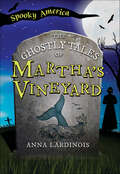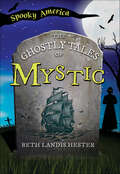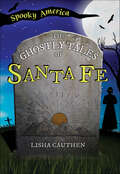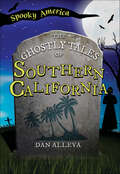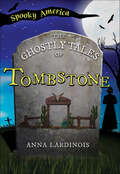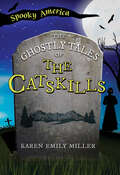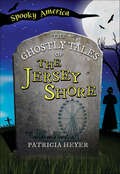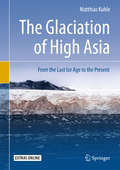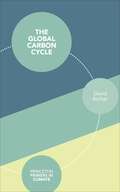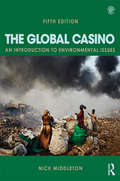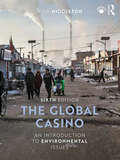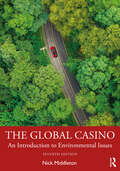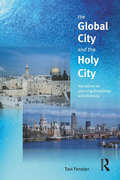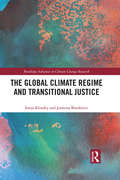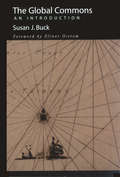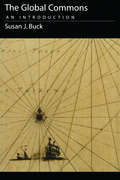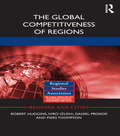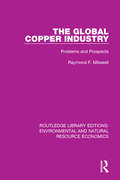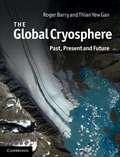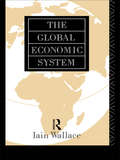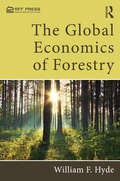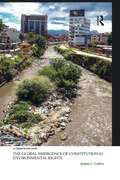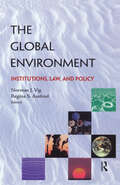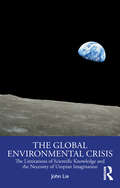- Table View
- List View
The Ghostly Tales of Martha's Vineyard (Spooky America)
by Anna LardinoisGhost stories from New England's famous island have never been so creepy, fun, and full of mystery! Welcome to the spooky streets of Martha's Vineyard! Stay alert! Ghosts lurk around every corner. Even the most unexpected places might be haunted by wandering phantoms. Did you know there's a house in Edgartown full of ghosts who refuse to leave? Or that the little girl who haunts a home in Vineyard Haven is just looking for a playmate? Can you believe the sound of the wailing wind is really a ghostly woman, searching for her husband who died at sea? Pulled right from history, these ghostly tales will change the way you see Martha's Vineyard, and have you sleeping with the light on!
The Ghostly Tales of Mystic (Spooky America)
by Beth HesterGhost stories from Connecticut's spookiest seaport have never been so creepy, fun, and full of mystery! Welcome to the spooky seaport of Mystic, Connecticut! Stay alert! Ghosts lurk around every corner. Even the most unexpected places might be haunted by wandering phantoms. Did you know that a friendly innkeeper still checks in on guests at the inn he owned…200 years ago? Or that there may be a fiery curse on Mystic dating back to colonial days? Can you believe the Mystic River may be home to a ghost ship? Pulled right from history, these ghostly tales will change the way you see Mystic, and have you sleeping with the light on!
The Ghostly Tales of Santa Fe (Spooky America)
by Lisha CauthenGhost stories from America's heart of the Southwest have never been so creepy, fun, and full of mystery! Welcome to the spooky streets of Santa Fe! Stay alert! Ghosts lurk around every corner. Even the most unexpected places might be haunted by wandering phantoms. Did you know a ghostly miner still roams the Sangre de Cristo Mountains looking for the treasure he lost? Or that the spirit of a Spanish solider wanders Santa Fe not realizing he's dead? Can you believe you may even spot the ghost of Billy the Kid playing cards in town? Pulled right from history, these ghostly tales will change the way you see Santa Fe, and have you sleeping with the light on!
The Ghostly Tales of Southern California (Spooky America)
by Dan AllevaGhost stories from Southern California have never been so creepy, fun, and full of mystery! Welcome to spooky Southern California! Stay alert! Ghosts lurk around every corner. Even the most unexpected places might be haunted by wandering phantoms. Did you know the Hollywood Forever Cemetery is home to ghostly movie stars? Or that some ghosts get to spend eternity at Disneyland, "The Happiest Place on Earth?" Can you believe spirits from all over have turned Silver City into a literal Ghost Town? Pulled right from history, these ghostly tales will change the way you see Southern California, and have you sleeping with the light on!
The Ghostly Tales of Tombstone (Spooky America)
by Anna LardinoisGhost stories from America's Old Wild West have never been so creepy, fun, and full of mystery! Welcome to the spooky streets of Tombstone, Arizona! Stay alert! Ghosts lurk around every corner. Even the most unexpected places might be haunted by wandering phantoms. Did you know that Tombstone is home to the most infamous shootout in Wild West history? Or that those rowdy outlaws are now gunslinging ghosts ? Can you believe there's a secret tunnel below Tombstone's streets and saloons…that just might lead to a haunted silver mine? Pulled right from history, these ghostly tales will change the way you see Tombstone, and have you sleeping with the light on!
The Ghostly Tales of the Catskills (Spooky America)
by Karen Emily MillerGhost stories from New York's upstate towns have never been so creepy, fun, and full of mystery! Welcome to the spooky Catskills! Stay alert! Ghosts lurk around every corner. Even the most unexpected places might be haunted by wandering phantoms. Did you know the ghost of a colonial solider still haunts a home in Kinderhook? Or that the place where Washington Irving wrote "The Legend of Sleepy Hollow" is just as spooky as that famous story? Can you believe New York's Catskill Mountains are home to a shape-shifting witch? Pulled right from history, these ghostly tales will change the way you see the Catskills and have you sleeping with the light on!
The Ghostly Tales of the Jersey Shore (Spooky America)
by Patricia HeyerGhost stories from down the shore have never been so creepy, fun, and full of mystery! Welcome to the spooky Jersey Shore! Stay alert! Ghosts lurk around every corner. Even the most unexpected places might be haunted by wandering phantoms. Did you know that many of the Jersey Shore's famous lighthouses are haunted? Or that restless ghosts from the past wander these moonlit shores? Can you believe musical apparitions may be rocking--and haunting --the Convention Hall in Asbury Park? Pulled right from history, these ghostly tales will change the way you see the Jersey Shore and have you sleeping with the light on!
The Glaciation of High Asia: From the Last Ice Age to the Present (Earth Sciences In The 21st Century Ser.)
by Matthias KuhleThis book summarizes four decades of glacial-geomorphological field research in Central and High Asia in an attempt to draw a significant link between Quaternary science research and paleoclimatology. Based on the latest geomorphological findings, this study offers a large-scale reconstruction of the Last Glacial Maximum (LGM) that in High Asia encompassed a total expanse of no less than three million km2, including the Central Tibetan plateau with 2.4 million km2. The author offers a complete reconstruction of the Late Glacial, Holocene, and Historical glacier advances as well as the successive Postglacial ablation stages extending to the present. Taken together, the findings presented here provide the first insights into a global-climatic impact of the Last Glacial Maximum in Central and High Asia with respect to the current interglacial stage. The comparative data analyses point to an inland glaciation at subtropical latitude covering an area larger than the Nordic inland glaciation in Greenland. These insights are facilitated by a methodological approach, unprecedented in modern Quaternary research, that combines high-quality panoramic photography with high-resolution satellite imagery. This combination of terrestrial and aerial perspectives enables scientists and readers alike to visualize the geomorphology of the landscape as a three-dimensional space. The author’s successful union of digital big data resources with classical geomorphological analysis offers an exciting new template for future research in Quaternary science and related fields.
The Global Carbon Cycle (Princeton Primers in Climate #1)
by David ArcherA must-have introduction to this fundamental driver of the climate systemThe Global Carbon Cycle is a short introduction to this essential geochemical driver of the Earth's climate system, written by one of the world's leading climate-science experts. In this one-of-a-kind primer, David Archer engages readers in clear and simple terms about the many ways the global carbon cycle is woven into our climate system. He begins with a concise overview of the subject, and then looks at the carbon cycle on three different time scales, describing how the cycle interacts with climate in very distinct ways in each. On million-year time scales, feedbacks in the carbon cycle stabilize Earth's climate and oxygen concentrations. Archer explains how on hundred-thousand-year glacial/interglacial time scales, the carbon cycle in the ocean amplifies climate change, and how, on the human time scale of decades, the carbon cycle has been dampening climate change by absorbing fossil-fuel carbon dioxide into the oceans and land biosphere. A central question of the book is whether the carbon cycle could once again act to amplify climate change in centuries to come, for example through melting permafrost peatlands and methane hydrates.The Global Carbon Cycle features a glossary of terms, suggestions for further reading, and explanations of equations, as well as a forward-looking discussion of open questions about the global carbon cycle.
The Global Casino, Fifth Edition: An Introduction to Environmental Issues
by Nick MiddletonThe Global Casino is an introduction to environmental issues which deals both with the workings of the physical environment and the political, economic and social frameworks in which the issues occur. Using examples from all over the world, the book highlights the underlying causes behind environmental problems, the human actions which have made them issues, and the hopes for solutions. It is a book about the human impact on the environment and the ways in which the natural environment impacts human society. The fifth edition has been fully revised and updated throughout, with new case studies, figures, and online resources such as downloadable figures and tables from the text and multiple choice questions for students, accessible at: www.routledge.com/cw/middleton. New topics covered in extended boxed case studies include payment for environmental services, ocean acidification, biofuels in Brazil, waste reduction through industrial symbiosis, and the long-term impact of natural disasters on vulnerable groups. Other approaches and concepts covered for the first time in this new edition include traditional ecological knowledge, environmental justice, the ‘resource curse’, and urban biodiversity. Eighteen chapters on key issues follow three initial chapters which outline the background contexts of the physical and human environments and the concept of sustainable development. Each chapter provides historical context for key issues, outlines why they have arisen, and highlights areas of controversy and uncertainty to appraise how issues can be resolved both technically and in political and economic frameworks. Each chapter also contains an updated critical guide to further reading and websites, as well as discussion points and essay questions. The text can be read in its entirety or individual chapters adopted as standalone reading. The Global Casino is an essential resource for students of the environment, geography, earth sciences and development studies. It provides comprehensive and inspirational coverage of all the major global environmental issues of the day in a style that is clear and critical.
The Global Casino: An Introduction to Environmental Issues
by Nick MiddletonThe Global Casino is an introduction to environmental issues which deals both with the workings of the physical environment and with the political, economic and social frameworks in which the issues occur. Using examples from all over the world, the book highlights the underlying causes behind environmental problems, the human actions which have made them issues, and the hopes for solutions. It is a book about the human impact on the environment and the ways in which the natural environment impacts human society. The sixth edition has been fully revised and updated throughout, with new case studies, figures, and online resources including a complete lecture course for tutors and multiple-choice questions for students. New concepts and topics covered for the first time in this edition include the green economy, the forest transition model, marine microplastic pollution, urban disasters, decommissioning of big dams, and the start of the Anthropocene. Recent international initiatives covered include the Paris Agreement on climate change, the Aichi Biodiversity Targets, and the Sendai Framework for managing disaster risk. New case studies include Morocco’s Noor concentrated solar power plant, desert recovery in Kuwait, and river management on the Huang Ho. Eighteen chapters on key issues follow three initial chapters which outline the background contexts of the physical and human environments and the concept of sustainable development. Each chapter provides historical context for key issues, outlines why they have arisen, and highlights areas of controversy and uncertainty to appraise how issues can be resolved both technically and in political and economic frameworks. Each chapter also contains an updated critical guide to further reading – many of them open access – and websites, as well as discussion points and essay questions. The text can be read in its entirety or individual chapters adopted as standalone reading. This book is an essential resource for students of the environment, geography, earth sciences and development studies. It provides comprehensive and inspirational coverage of all the major global environmental issues of the day in a style that is clear and critical.
The Global Casino: An Introduction to Environmental Issues
by Nick MiddletonThe Global Casino is an introduction to environmental issues which deals both with the workings of the physical environment and the political, economic and social frameworks in which the issues occur. Using examples from all over the world, the book highlights the underlying causes behind environmental problems, the human actions which have made them issues and the hopes for solutions. It is a book about the human impact on the environment and the ways in which the natural environment impacts human society.The seventh edition has been fully revised and updated throughout, with new case studies, figures and online resources comprising a complete lecture course for tutors and multiple-choice questions for students. New concepts and topics covered for the first time in this edition include the blue economy, marine heatwaves, Africa’s Great Green Wall, rewilding, net-zero commitments, nature-based solutions, emerging contaminants in global rivers, green infrastructure in sustainable cities, initiatives promoting zero-emission vehicles, and zoonotic diseases (including the COVID-19 pandemic). New case studies include gender impact assessment of big dams in Laos and Vietnam, reducing food loss and waste, liming sugar maple trees in North America to counteract soil acidification and soil erosion and poverty in Rwanda. Eighteen chapters on key issues follow three initial chapters which outline the background contexts of the physical and human environments and the concept of sustainable development. Each chapter provides historical context for key issues, outlines why they have arisen and highlights areas of controversy and uncertainty to appraise how issues can be resolved both technically and in political and economic frameworks. Each chapter also contains an updated critical guide to further reading—most of them open access—and websites, talks and podcasts, as well as discussion points and essay questions. The text can be read in its entirety or individual chapters adopted as standalone reading.This book is an essential resource for students of the environment, geography, development studies and earth sciences. It provides comprehensive and inspirational coverage of all the major global environmental issues of the day in a style that is clear, concise and critical.
The Global Circulation of the Atmosphere
by Tapio Schneider & Adam H. SobelDespite major advances in the observation and numerical simulation of the atmosphere, basic features of the Earth's climate remain poorly understood. Integrating the available data and computational resources to improve our understanding of the global circulation of the atmosphere remains a challenge. Theory must play a critical role in meeting this challenge. This book provides an authoritative summary of the state of the art on this front. Bringing together sixteen of the field's leading experts to address those aspects of the global circulation of the atmosphere most relevant to climate, the book brings the reader up to date on the key frontiers in general circulation theory-including the nonlinear and turbulent global-scale dynamics that determine fundamental aspects of the Earth's climate. While emphasizing theory, as expressed through relatively simple mathematical models, it also draws connections to simulations with comprehensive general circulation models. Topics include the dynamics of storm tracks, interactions between wave dynamics and the hydrological cycle, monsoons, tropical and extratropical dynamics and interactions, and the processes controlling atmospheric humidity. An essential resource for graduate students in atmospheric, ocean, and climate sciences and for researchers seeking an overview of the field, The Global Circulation of the Atmosphere sets the standard for future research in a science that stands at a critical juncture. With a foreword by Edward Lorenz, the book includes chapters by Christopher Bretherton; Kerry Emanuel; Isaac Held; David Neelin; Raymond Pierrehumbert, Hélène Brogniez, and Rémy Roca; Alan Plumb; Walter Robinson; Tapio Schneider; Richard Seager and David Battisti; Adam Sobel; Kyle Swanson; and Pablo Zurita-Gotor and Richard Lindzen.
The Global City and the Holy City: Narratives on Knowledge, Planning and Diversity
by Tovi FensterThe Global City & the Holy City explores the local embodied knowledge of women and men of different national, cultural and ethnic identities and age groups, living in London and Jerusalem. Their narratives focus on the three main concepts of Comfort, Belonging and Commitment to the various spaces in which they live. By deconstructing the meanings of these three notions and analyzing their expression in cognitive temporal maps, The Global City & The Holy City examines the practicalities of incorporating this kind of local embodied knowledge into the professional planning and management of cities in the age of globalization.
The Global Climate Regime and Transitional Justice (Routledge Advances in Climate Change Research)
by Jasmina Brankovic Sonja KlinskyGeopolitical changes combined with the increasing urgency of ambitious climate action have re-opened debates about justice and international climate policy. Mechanisms and insights from transitional justice have been used in over thirty countries across a range of conflicts at the interface of historical responsibility and imperatives for collective futures. However, lessons from transitional justice theory and practice have not been systematically explored in the climate context. The comparison gives rise to new ideas and strategies that help address climate change dilemmas. This book examines the potential of transitional justice insights to inform global climate governance. It lays out core structural similarities between current global climate governance tensions and transitional justice contexts. It explores how transitional justice approaches and mechanisms could be productively applied in the climate change context. These include responsibility mechanisms such as amnesties, legal accountability measures, and truth commissions, as well as reparations and institutional reform. The book then steps beyond reformist transitional justice practice to consider more transformative approaches, and uses this to explore a wider set of possibilities for the climate context. Each chapter presents one or more concrete proposals arrived at by using ideas from transitional justice and applying them to the justice tensions central to the global climate context. By combining these two fields the book provides a new framework through which to understand the challenges of addressing harms and strengthening collective climate action. This book will be of great interest to scholars and practitioners of climate change and transitional justice.
The Global Commons: An Introduction
by Elinor Ostrom Susan J. BuckVast areas of valuable resources unfettered by legal rights have, for centuries, been the central target of human exploitation and appropriation. The global commons -- Antarctica, the high seas and deep seabed minerals, the atmosphere, and space -- have remained exceptions only because access has been difficult or impossible, and the technology for successful extraction has been lacking. Now, technology has caught up with desire, and management regimes are needed to guide human use of these important resource domains.In The Global Commons, Susan Buck considers the history of human interactions with each of the global commons areas and provides a concise yet thorough account of the evolution of management regimes for each area. She explains historical underpinnings of international law, examines the stakeholders involved, and discusses current policy and problems associated with it.Buck applies key analytical concepts drawn from institutional analysis and regime theory to examine how legal and political concerns have affected the evolution of management regimes for the global commons. She presents in-depth case studies of each of the four regimes, outlining the historical evolution of the commons -- development of interest in exploiting the resource domain; conflicts among nations over the use of the commons; and efforts to design institutions to control access to the domains and to regulate their use -- and concluding with a description of the management regime that eventually emerged from the informal and formal negotiations.The Global Commons provides a clear, useful introduction to the subject that will be of interest to general readers as well as to students in international relations and international environmental law, and in environmental law and policy generally.
The Global Commons: An Introduction
by Susan J. BuckAntarctica, the high seas and deep seabed, the atmosphere, and space are increasingly accessible - and exploited - resource domains. Collectively known as the global commons, they represent a new and profound challenge for international law and institutions. In The Global Commons, Susan Buck considers the unique physical, legal, management, and policy problems associated with these areas. The book is a clear, useful introduction to the subject that will be of interest to general readers as well as to students in international relations, international law, and environmental law and policy.
The Global Competitiveness of Regions (Regions and Cities)
by Robert Huggins Hiro Izushi Daniel Prokop Piers ThompsonThe aim of this book is to consider theoretically the notion of the global competitiveness of regions, as well as giving attention as to how such competitiveness may be empirically measured. With this in mind, the book has three specific objectives: first, to place the concept of regional competitiveness within the context of regional economic development theory; second, to present a rationale and method for quantifying the global competitiveness of regions; and, third, to undertake the most geographically widespread analysis of regional competitiveness differences across the globe. With regard to the third goal, the analysis incorporates more than 500 regions across Europe, North and South America, Asia-Pacific, the Middle East, and the so-called BRIC economies of Brazil, Russia, India, and China. The importance of the concept of competitiveness has increased rapidly in recent years, with the issues surrounding it becoming, at the same time, more empirically refined and theoretically complex. The focus on regions reflects the growing consensus that they are the primary spatial units that compete to attract investment, and it is at the regional level that knowledge is circulated and transferred, resulting in agglomerations, or clusters, of industrial and service sector enterprises. This growing acknowledgement of the region’s role as a key spatial unit of organisation has led to attention turning to competitiveness at a more regional level. The book explores the results of the World Competitiveness Index of Regions (WCIR), covering the rankings and results of the 2014 edition. The WCIR provides a tool for analysing the development of a range of regional economies across the globe. It enables an illustration of the changing patterns of regional competitiveness on the international stage to be generated. In fundamental terms, the WCIR aims to produce an integrated and overall benchmark of the knowledge capacity, capability, and sustainability of each region, and the extent to which this knowledge is translated into economic value and transferred into the wealth of the citizens of each region.
The Global Copper Industry: Problems and Prospects (Routledge Library Editions: Environmental and Natural Resource Economics)
by Raymond F. MikesellOriginally published in 1988. Copper is one of the most actively traded commodities. It is a crucial commodity for industrialised countries, most of which depend on imports for their supplies. Copper is also the single most important export for many of the producer-countries. Changes in the patterns of the world trade in copper therefore have an important impact on many countries. This book surveys the state of the world copper industry as it was in the 1980s. It discusses the state of production, demand and trade and assesses trends. Special emphasis is given to the outlook for over capacity, prices and competitive structure.
The Global Cryosphere
by Thian Yew Gan Roger G. BarryThis is the first textbook to address all the components of the Earth's cryosphere - all forms of snow and ice, both terrestrial and marine. It provides a concise but comprehensive summary of snow cover, glaciers, ice sheets, lake and river ice, permafrost, sea ice and icebergs - their past history and projected future state. It is designed for courses at upper undergraduate and graduate level in environmental science, geography, geology, glaciology, hydrology, water resource engineering and ocean sciences. It also provides a superb up-to-date summary for researchers of the cryosphere. The book includes an extensive bibliography, numerous figures and color plates, thematic boxes on selected topics and a glossary. The book builds on courses taught by the authors for many decades at the University of Colorado and the University of Alberta. Whilst there are many existing texts on individual components of the cryosphere, no other textbook covers the whole cryosphere.
The Global Economic System
by I. WallaceThe author provides a treatment of world economic geography as a whole. He sets out the historical context of the modern world along with the principal philosophies that have shaped our study of it, and identifies the importance of the biophysical environment as well as cultural and political settings for economic activity.
The Global Economics of Forestry
by William F. HydeThis book traces the economic and biological pattern of forest development from initial settlement and harvest activity at the natural forest frontier to modern industrial forest plantations. It builds from diagrams describing three discrete stages of forest development, and then discusses the management and policy implications associated with each, supporting its observations with examples and data from six continents and from both developed and developing countries. It shows that characteristic distinctions between the three stages make forestry unusual in natural resource management and that effective policy requires different, even contrasting, decisions at each stage. William F. Hyde’s comprehensive discussion covers a wide range of issues, including the impacts of both specific forest policies and broader macroeconomic policies, the unique requirements of current issues such as global warming, biodiversity and tourism, and the complexities of the different forest products industries. Concluding chapters review the roles of the newer institutional landowners, of smaller private and farm landowners, and of public agencies. This highly-original volume reaches far beyond forest economics; it explains what forestry can do for regional development and environmental conservation and what policies designed for other sectors and the macro-economy can do for forestry.
The Global Emergence of Constitutional Environmental Rights (Law, Justice and Ecology)
by Joshua C. GellersOver the past 40 years, countries throughout the world have similarly adopted human rights related to environmental governance and protection in national constitutions. Interestingly, these countries vary widely in terms of geography, politics, history, resources, and wealth. This raises the question: why do some countries have constitutional environmental rights while others do not? Bringing together theory from law, political science, and sociology, a global statistical analysis, and a comparative study of constitutional design in South Asia, Gellers presents a comprehensive response to this important question. Moving beyond normative debates and anecdotal developments in case law, as well as efforts to describe and categorize such rights around the world, this book provides a systematic analysis of the expansion of environmental rights using social science methods and theory. The resulting theoretical framework and empirical evidence offer new insights into how domestic and international factors interact during the constitution drafting process to produce new law that is both locally relevant and globally resonant. Scholars, practitioners, and students of law, political science, and sociology interested in understanding how institutions cope with complex problems like environmental degradation and human rights violations will find this book to be essential reading.
The Global Environment: Institutions, Law and Policy
by Regina S. Axelrod Norman J. VigAll serious environmental threats are now international in scope and more than one thousand international environmental agreements already exist. Yet the prospects for international cooperation leading to the management of impacts on the planet remain grim. The Global Environment meets the need for an authoritative assessment of the state of international environmental institutions, laws and policies at the end of the 20th century.The book examines disagreements over the meaning of sustainable development, problems inherent in implementing environmental policies and the conflict over the exclusion of developing countries from the Kyoto Protocol. It discusses the profound trade-offs that may be required, the role of international financial interests in promoting incompatible forms of development and analyses international environmental institutions, law and policy and sustainable development.
The Global Environmental Crisis: The Limitations of Scientific Knowledge and the Necessity of Utopian Imagination
by John LieThe Global Environmental Crisis presents a new perspective on our inattention and inaction in the face of a major crisis. We cannot proceed without scientific knowledge, but we cannot exclusively rely on it. What we need, in addition to scientific knowledge, is utopian imagination to make us understand the nature of the crisis and to suggest an alternative vision of a viable future. This book is an essential resource for students and instructors across the social sciences, especially sociology and environmental studies. It will also be a crucial and accessible text for general readers interested in climate change and how to imagine a better world for themselves and future generations.
